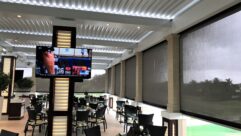Can We Sole Source?
When it comes to writing specifications for individual AV components, the pro AV industry may need to do things a bit differently ? once again.
A BIG part of what AV consultants do for a living is produce drawings and specifications for bidding or negotiated pricing. The drawings depict what connects to what, how it connects, and where it goes. The specifications (or “specs” as they’re often called) explain the terms of the contract, the project administrative requirements, what products to use, and how they should be installed. The AV specs may be just one section or a set of sections that are incorporated into a larger set of whole-project specifications. Sometimes a comprehensive package is produced that includes the “front end” administrative sections, plus all of the contract information and technical specifications to form a complete contract package.
In any case, included somewhere in the specifications is language that spells out which products are acceptable to use — both for pricing the contract and for the installation. This is usually Part 2 of the Construction Specifications Institute’s (CSI) classic three-part specification format (likely to soon be four parts, but that’s another story). Part 2 is usually entitled “Equipment,” and specifies the products to be used. In traditional construction specifications, this is usually a single or a few specific products described somewhat generically, identifying salient characteristics of the product’s physical aspects as well as its performance.
In pro AV, we tried to adopt this traditional approach for many years until it became unwieldy for us. Part 2 is typically fine for a single product or a system with just a few components that need to be described. However, it becomes a problem when hundreds of products are involved, as in many mid- to large-sized AV projects.
One goal of this traditional approach, which is also often required by the owner, is to be specific enough to define the required performance of a particular component, while leaving it open to several manufacturers to fill this need. Again, this works for many bricks and mortar commodity products such as gypsum board and steel, as well as traditional systems components such as fans and transformers. However, for the more complicated low-voltage systems such as networks and AV systems, this approach may not be as feasible.
Part 2: Different for AV
Though AV consultants have a variety of ways of writing and organizing their specifications, many of the problems that come up in the process are quite similar. Issues in Part 2 generally have to do with two basic characteristics of the spec: the length of the product descriptions, and how many products to allow for each item. For the most traditional approach, each product includes a paragraph describing it, along with a list of acceptable substitutes (traditionally three), by manufacturer and model number. This can require a lot of potentially unnecessary spec writing for a larger AV project.
To reduce the “overhead” in the spec-writing process, a spec writer can cut text in three ways:
Option 1: Keep the description, and list one manufacturer and model number, then allow “comparable” products (or the infamous “or equal”) from other manufacturers by brand, rather than model number. This cuts the specific model number research by two thirds.
Option 2: List the acceptable products as above, and scrap the descriptive paragraph. This list establishes the basis for design for each product against which any potential substitution would be evaluated. One of the problems with the product description is that it’s sometimes impossible to have a meaningful and accurate paragraph of text for three different manufacturer’s products that would all be acceptable. This is particularly true when using manufacturer-provided specification text intended to lock-out other products. Eliminating the text reduces a huge amount of work.
Option 3: Provide an equipment list including only manufacturer and model number as a basis for design, and then allow comparable products on a case-by-case basis with text describing the submittal process to do so. This allows for variations in the products to be used without an excessive amount of unnecessary text.
Although some would argue that reducing the language in the specifications opens the contract it ultimately becomes to interpretation, my experience is that Options 2 and 3 make for a more efficient specification preparation, easier bidding, and often fewer issues with the contract during construction while still allowing the possibility for product substitution.
Design vs. product substitution
While there are some architectural products that are unique in what or how they do what they do, we seem to have a higher unique-to-commodity product ratio in pro AV. Not only that, but there are many times when there truly are no “equals.” A substitution in one piece of equipment in the system may require a different design approach altogether, thus potentially opening Pandora’s Box.
If substituting one piece of equipment requires some redesign, should this be an option? Most often the answer is no. If a system design is properly vetted before releasing for bidding and/or pricing, then the design approach should be justifiable as the best option for the end-users’ needs. The answer can be different if the design is somehow inadequate.
In a well-designed project, there may be products that can be substituted (say, for commodity products such as cable, distribution amplifiers, racks, and the like) and some that should be limited to only one or perhaps two specialty products (such as some large routers, DSP devices, codecs, and perhaps control systems). The limitations on allowable substitutions are required to maintain the integrity of the design or to accommodate an end-users’ pre-existing environment or equipment standards.
The sole source
When a design approach requires the use of a particular manufacturer’s product, the AV integrator specifies this product without the option for a substitution. Known as a sole-source specification, this can be problematic for some owners — particularly some government agencies and recipients of their funds —even though it may ultimately benefit the end-users. While many organizations want to encourage competition and decrease cost, there are occasions where the competition is more about function, quality, and compatibility than price. In these cases, the competition takes place during design rather than bidding.
If sole sourcing can be properly justified in the design, there still may be organizational and policy obstacles to issuing the specification. Government agencies are particularly sensitive to this issue, and with good reason. Sole sourcing can be the result of simple vendor preference, or it could come from more nefarious motivations. But if it’s functionally as well as economically called for, sole sourcing isn’t as unacceptable as some agencies might think.
A 1974 Massachusetts court case — Whitten Corp. vs. Paddock Inc. — questioned the sole source exclusion from every government specification. The ruling was that sole-source specifications are acceptable when they benefit the owner. Based on the ruling, it’s up to the consultant to allow a substitution whether “or equal” was specified or not, to the point that the specifier “may waive specifications to obtain a more desirable product for the client.”
This case went to the Supreme Court for appeal and was declined for review, affirming the lower Federal Court ruling. This case has set a still relatively unknown precedent for both federal, and arguably state, policies about required product alternatives. It has benefits for both sides of an AV integration contract, but gives the specifier the ultimate decision-making responsibility, and holds the manufacturer responsible for proving its product is “equal.”
Similar, but different
Sole sourcing is an issue shared between pro AV and our architect/engineer (A/E) brethren. But, of course, it’s a bit different for us. We may need to occasionally sole source a product or two as other building industries do, but the fact that we have hundreds of products that fall into one or two specification sections may require us to deviate from the rest of the design team’s spec writing rules. We must continue to work within our own industry to come up with the best way to write and respond to AV specifications in a way that works for both AV and A/E. At the same time, we need to keep the rest of the building design and owner communities up to speed on why we may need to be different once again.
Tim Cape is a contributing editor for Pro AV, the principal consultant for Atlanta-based technology consulting firm Technitect LLC, and co-author of “AV Best Practices,” published by InfoComm International. He’s the current chairman of InfoComm’s ICAT consultant’s council, and an instructor and presenter in AV technology design and management. Contact him at[email protected].










